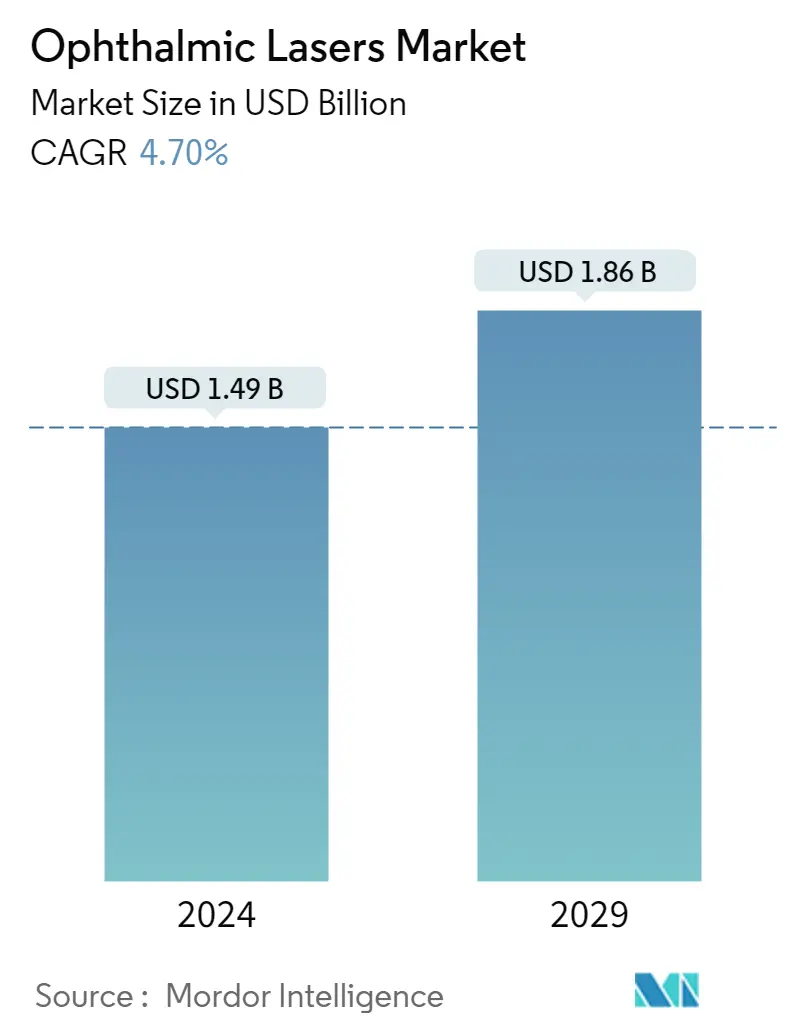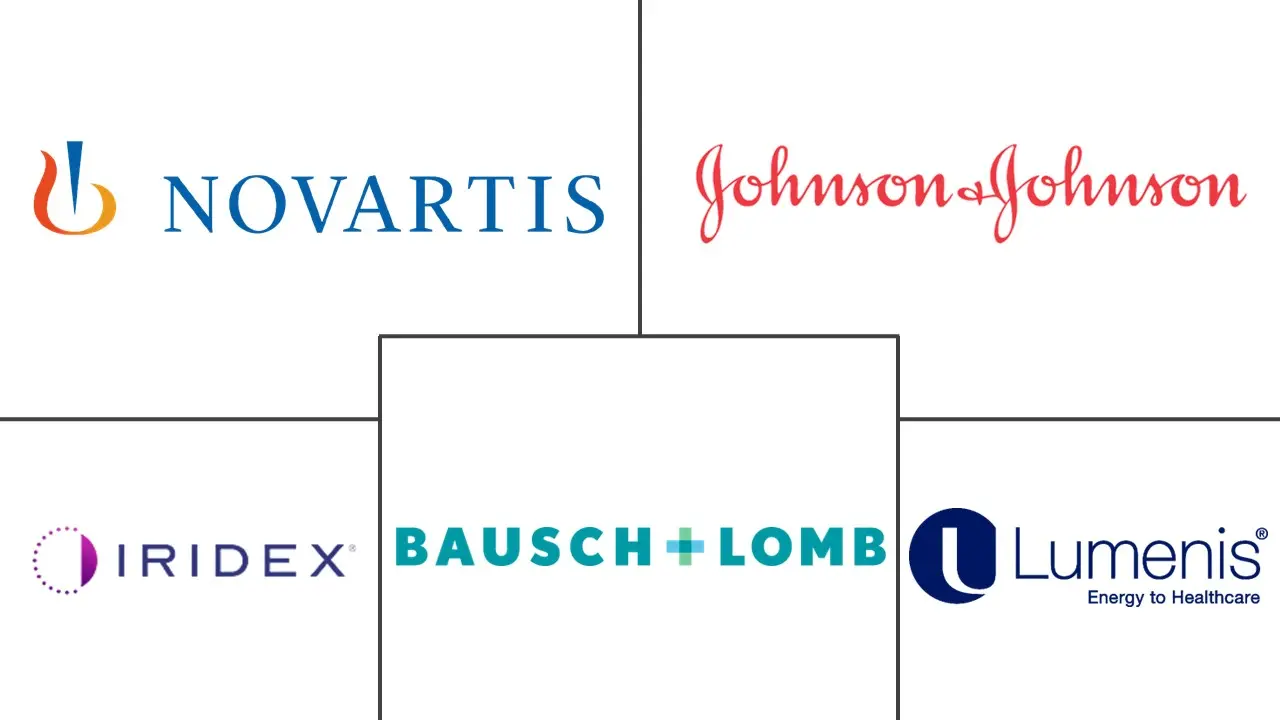Market Size of Ophthalmic Lasers Industry

| Study Period | 2019 - 2029 |
| Market Size (2024) | USD 1.49 Billion |
| Market Size (2029) | USD 1.86 Billion |
| CAGR (2024 - 2029) | 4.70 % |
| Fastest Growing Market | Asia Pacific |
| Largest Market | North America |
| Market Concentration | Medium |
Major Players
*Disclaimer: Major Players sorted in no particular order |
Ophthalmic Lasers Market Analysis
The Ophthalmic Lasers Market size is estimated at USD 1.49 billion in 2024, and is expected to reach USD 1.86 billion by 2029, growing at a CAGR of 4.70% during the forecast period (2024-2029).
The healthcare system witnessed enormous challenges as a result of the COVID-19 pandemic. All outpatient treatments were postponed or restricted during the COVID-19 pandemic to reduce the risk of viral transmission, as most chronic therapies were regarded as non-urgent. An article published in the Journal of Ophthalmic and Vision Research in December 2021 indicated that COVID-19 had caused ocular problems both directly and indirectly, and the further causes of concern are side effects of COVID-19 treatment and indirect consequences of lockdowns and shelter-in-place orders. The article also stated that the huge morbidity and death toll imposed by the pandemic has led to the adoption of life-saving treatment protocols with the downside of complications. Such hindrances are affecting the growth of the ophthalmic lasers market. However, the market is opening up, and with product launches and other initiatives, it is expected to grow during the forecast period.
According to the WHO 2021, around the world, at least 2.2 billion people have near or distant vision impairment. In at least around 1 billion or almost half of these cases, vision impairment could have been prevented or has yet to be addressed. As per the same source, vision impairment poses a global financial burden associated with vision impairment from uncorrected myopia (USD 244 billion) and presbyopia (USD 25.4 billion). The large prevalence of ophthalmic disorders around the world is adding to the growth of the ophthalmic lasers market.
Similarly, in January 2022, a press release by the World Economic Forum stated that rates of short-sightedness (myopia) are rising dramatically. By 2050, it's even predicted that half of the world's population would be short-sighted. These rates alone have risen in the past 50 years in Europe. According to the study, women were 24% more likely than men to develop myopia as children, but they were 12% less likely to do so as adults. It's unclear why this is the case, but it could be because men and women endure different hormonal shifts or different lifestyles. Thus, the increasing prevalence of myopia is expected to increase market growth during the forecast period as the patient often requires surgical treatments which involve ophthalmic lasers.
Initiatives by key market players are further expected to increase market growth during the forecast period. In April 2022, Nova Eye Medical launched its next-generation canaloplasty device, iTrack Advance, in select markets in Europe and Asia-Pacific. The iTrack Advance features include a proprietary illuminated fiber optic tip of the original iTrack device to allow the surgeon to continuously monitor the location of the device in Schlemm's canal. Thus, such initiatives are expected to increase market growth.
However, the high cost associated with laser therapies and the low availability of skilled practitioners are expected to restrict the growth of the studied market over the forecast period.
Ophthalmic Lasers Industry Segmentation
As per the scope, the ophthalmic laser is a medical device used to target ophthalmic cells in order to operate ophthalmic disorders. Ophthalmic lasers are used for treating a wide range of eye problems. They are used in various ophthalmic disorder procedures, including cataract surgery, laser trabeculoplasty, retinal photocoagulation, and laser iridotomy. Significant accuracy, low-cost, safe procedure, and convenient ophthalmic tools have increased the demand for ophthalmic lasers in the market. The ophthalmic lasers market is segmented by product (diode lasers, femtosecond lasers, excimer lasers, Nd: YAG Lasers, and other products), application (glaucoma, cataract removal, refractive error corrections, diabetic retinopathy, and other applications), end user (hospitals, eye clinics, and other end users) and geography (North America, Europe, Asia-Pacific, Middle East & Africa, and South America). The report also covers the estimated market sizes and trends of 17 countries across major regions globally. The report offers values in (in USD million) for the above segments.
| By Product | |
| Diode Lasers | |
| Femtosecond Lasers | |
| Excimer Lasers | |
| Nd:YAG Lasers | |
| Other Products |
| By Application | |
| Glaucoma | |
| Cataract Removal | |
| Refractive Error Corrections | |
| Diabetic Retinopathy | |
| Other Applications |
| By End User | |
| Hospitals | |
| Eye Clinics | |
| Other End Users |
| Geography | ||||||||
| ||||||||
| ||||||||
| ||||||||
| ||||||||
|
Ophthalmic Lasers Market Size Summary
The ophthalmic lasers market is poised for growth, driven by the increasing prevalence of vision impairment and ophthalmic disorders globally. The market is recovering from the challenges posed by the COVID-19 pandemic, which had temporarily hindered outpatient treatments and led to a backlog in non-urgent chronic therapies. Despite these setbacks, the market is expected to expand due to the rising incidence of conditions such as myopia and the demand for surgical interventions involving ophthalmic lasers. Key players in the industry are actively launching new products and technologies, such as Nova Eye Medical's iTrack Advance, to enhance treatment options and drive market growth. However, the high costs associated with laser therapies and the scarcity of skilled practitioners may pose challenges to market expansion.
The refractive error corrections segment dominates the ophthalmic lasers market, supported by the high prevalence of unaddressed refractive errors and the development of advanced surgical procedures like LASIK. Technological advancements and increased awareness of innovative vision correction surgeries, particularly in North America, are contributing to market growth. Regulatory approvals for new products, such as LASEROPTEK's PicoLO Premium, further bolster market prospects. The competitive landscape is characterized by the presence of major players like Novartis AG, Johnson & Johnson Surgical Vision Inc., and Bausch Health Companies Inc., with potential for new entrants due to the growing geriatric population and rising ophthalmic cases. Overall, the market is expected to benefit from ongoing research and development, as well as the increasing necessity for ophthalmic laser surgeries.
Ophthalmic Lasers Market Size - Table of Contents
-
1. MARKET DYNAMICS
-
1.1 Market Overview
-
1.2 Market Drivers
-
1.2.1 High Prevalence of Ophthalmic Disorders
-
1.2.2 Increasing Regulatory Approvals for Ophthalmic Lasers
-
1.2.3 Increasing Initiatives to Control Visual Impairments
-
-
1.3 Market Restraints
-
1.3.1 Huge Cost Associated with Ophthalmic Laser Therapies
-
1.3.2 Reduced Availability of Skilled Practitioners
-
-
1.4 Porter's Five Forces Analysis
-
1.4.1 Threat of New Entrants
-
1.4.2 Bargaining Power of Buyers/Consumers
-
1.4.3 Bargaining Power of Suppliers
-
1.4.4 Threat of Substitute Products
-
1.4.5 Intensity of Competitive Rivalry
-
-
-
2. MARKET SEGMENTATION (Market Size by Value - USD million)
-
2.1 By Product
-
2.1.1 Diode Lasers
-
2.1.2 Femtosecond Lasers
-
2.1.3 Excimer Lasers
-
2.1.4 Nd:YAG Lasers
-
2.1.5 Other Products
-
-
2.2 By Application
-
2.2.1 Glaucoma
-
2.2.2 Cataract Removal
-
2.2.3 Refractive Error Corrections
-
2.2.4 Diabetic Retinopathy
-
2.2.5 Other Applications
-
-
2.3 By End User
-
2.3.1 Hospitals
-
2.3.2 Eye Clinics
-
2.3.3 Other End Users
-
-
2.4 Geography
-
2.4.1 North America
-
2.4.1.1 United States
-
2.4.1.2 Canada
-
2.4.1.3 Mexico
-
-
2.4.2 Europe
-
2.4.2.1 Germany
-
2.4.2.2 United Kingdom
-
2.4.2.3 France
-
2.4.2.4 Italy
-
2.4.2.5 Spain
-
2.4.2.6 Rest of Europe
-
-
2.4.3 Asia-Pacific
-
2.4.3.1 China
-
2.4.3.2 Japan
-
2.4.3.3 India
-
2.4.3.4 Australia
-
2.4.3.5 South Korea
-
2.4.3.6 Rest of Asia-Pacific
-
-
2.4.4 Middle East and Africa
-
2.4.4.1 GCC
-
2.4.4.2 South Africa
-
2.4.4.3 Rest of Middle East and Africa
-
-
2.4.5 South America
-
2.4.5.1 Brazil
-
2.4.5.2 Argentina
-
2.4.5.3 Rest of South America
-
-
-
Ophthalmic Lasers Market Size FAQs
How big is the Ophthalmic Lasers Market?
The Ophthalmic Lasers Market size is expected to reach USD 1.49 billion in 2024 and grow at a CAGR of 4.70% to reach USD 1.86 billion by 2029.
What is the current Ophthalmic Lasers Market size?
In 2024, the Ophthalmic Lasers Market size is expected to reach USD 1.49 billion.

